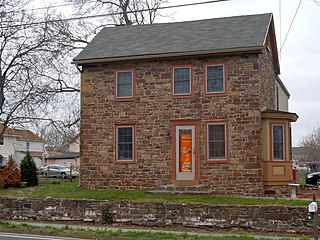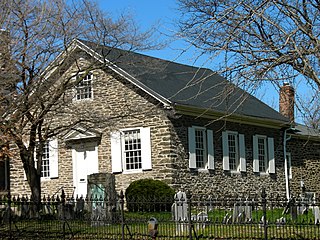
Skippack is a census-designated place (CDP) in Montgomery County, Pennsylvania, United States. The population was 3,758 at the 2010 census.

The Pennsylvania Dutch, translated from German to English as Pennsylvania Germans, are a cultural group formed by German immigrants settling in the state of Pennsylvania during the 18th and 19th centuries. These emigrated primarily from German-speaking territories of Europe, now partly within modern-day Germany, but also from the Netherlands, Switzerland and France's Alsace-Lorraine Region, traveling down the Rhine river to seaports.

Germantown is an area in Northwest Philadelphia. Founded by German, Quaker, and Mennonite families in 1683 as an independent borough, it was absorbed into Philadelphia in 1854. The area, which is about six miles northwest from the city center, now consists of two neighborhoods: 'Germantown' and 'East Germantown'.

The Old German Baptist Brethren (OGBB) is a conservative Plain church which emerged from a division among the German Baptist Brethren in 1881 being part of the Old Order Movement. Like the church it emerged from, it has roots both in Anabaptism and in Radical Pietism. It practices adult believers baptism as the biblically valid form of baptism. It is also characterized by strict religious adherence with rejection of modern culture and modern assimilation. It is one of several Schwarzenau Brethren groups that trace their roots to 1708, when eight believers founded a new church in Schwarzenau, Germany. The Old German Baptist Brethren church has about 4,000 baptized members.

The Schwarzenau Brethren, the German Baptist Brethren, Dunkers, Dunkards, Tunkers, or sometimes simply called the German Baptists, are an Anabaptist group that dissented from Roman Catholic, Lutheran and Reformed European state churches during the 17th and 18th century. German Baptist Brethren emerged in some German-speaking states in western and southwestern parts of the Holy Roman Empire as a result of the Radical Pietist revival movement of the late 17th and early 18th centuries.

The Brethren Church is an Anabaptist Christian denomination with roots in and one of several groups that trace its origins back to the Schwarzenau Brethren of Germany.

The Dunkard Brethren are a small group of primarily American conservative Schwarzenau Brethren, which organized in 1926 when they withdrew from the Church of the Brethren in the United States. In 1980 they had approximately 900 members in 25 congregations, primarily in mid-Atlantic and midwestern states that had been areas of German settlement in the colonial and later periods.

Mount Airy is a neighborhood of Northwest Philadelphia in the U.S. state of Pennsylvania.

The Lutheran Theological Seminary at Philadelphia (LTSP), also known as the Philadelphia Seminary, was one of eight theological seminaries associated with the Evangelical Lutheran Church in America, the largest Lutheran denomination in North America. It is located on Germantown Avenue in the Mount Airy neighborhood of northwestern Philadelphia. Founded in 1864, it has its roots in the Pennsylvania Ministerium established in 1748 in Philadelphia by Henry Melchior Muhlenberg.

The Pennsylvania Ministerium was the first Lutheran church body in North America. With the encouragement of Henry Melchior Muhlenberg (1711–1787), the Ministerium was founded at a Church Conference of Lutheran clergy on August 26, 1748. The group was known as the "German Evangelical Lutheran Ministerium of North America" until 1792, when it adopted the name "German Evangelical Lutheran Ministerium of Pennsylvania and Adjacent States".
Old York Road is a roadway that was built in the 18th century to connect Philadelphia with New York City. Through New Jersey it was built along the Raritan "Naraticong Trail", also known as the Tuckaraming Trail. A memorial plaque to the friendship of the Naraticong Indians, who permitted the road to be built over their trail, sits at the intersection of Old York Road and Canal in Raritan, NJ. The Swift Sure Stage Coach Line completed the journey between the two cities in two days and cost only a few dollars.
Manada Hill, is an unincorporated community in East Hanover Township, Dauphin County, Pennsylvania, United States, adjoining the census-designated place of Skyline View. The village is bounded to the east along Route 39 at the intersection with Jonestown Road to the north, Manada View Drive to the south and Manada Creek to the east.

The Evansburg Historic District in Evansburg, Pennsylvania, United States, is a National Historic District designated by Congress with over 50 National Register properties dating from the early 18th through 19th century. Almost all of these properties are privately owned and in active use at this time. The Evansburg Historic District was listed on the National Register of Historic Places in 1972.

Mennonite Meetinghouse is a historic Mennonite church building at 6119 Germantown Avenue in Philadelphia, Pennsylvania.

The Concord School House is a historic one-room schoolhouse in the Germantown section of Philadelphia, Pennsylvania. It is operated today as a museum. It is part of the Colonial Germantown Historic District which was named a National Historic Landmark District in 1965.

Liberty Universalist Church and Feasterville Academy Historic District is a national historic district located near Winnsboro, Fairfield County, South Carolina. The property encompasses four buildings constructed between 1831 and 1845. They are the Liberty Universalist Church and three buildings associated with the Academy: a boarding house, a kitchen, and a school building. The buildings were constructed by the Feaster family.

The Beggarstown School, built c. 1740, is a historic school in Beggarstown, Philadelphia, Pennsylvania, now part of the Mount Airy neighborhood. It is a rare example of a colonial era school building.
The Lutheran Home in Germantown, now Silver Springs – Martin Luther School, began in 1859 as an orphanage for children that was originally located in the Mt. Airy, Philadelphia. This institution was a continuation of the work of Rev. William A. Passavant but was founded and managed by Elizabeth Fry Ashmead Schaeffer, who received a single dollar from Passavant and began the mission. The Lutheran Home in Germantown later moved to the Silver Springs property in Plymouth Meeting, Pennsylvania, where it continues as a residential treatment facility for children and school for elementary students and middle schoolers.

St. Michael's Evangelical Lutheran Church is a historic church building in the Mount Airy neighborhood of Philadelphia, just north of the Germantown neighborhood. The congregation was founded sometime before 1728 and three successive church buildings have occupied the same location since that time. The church was closed in 2016.
















